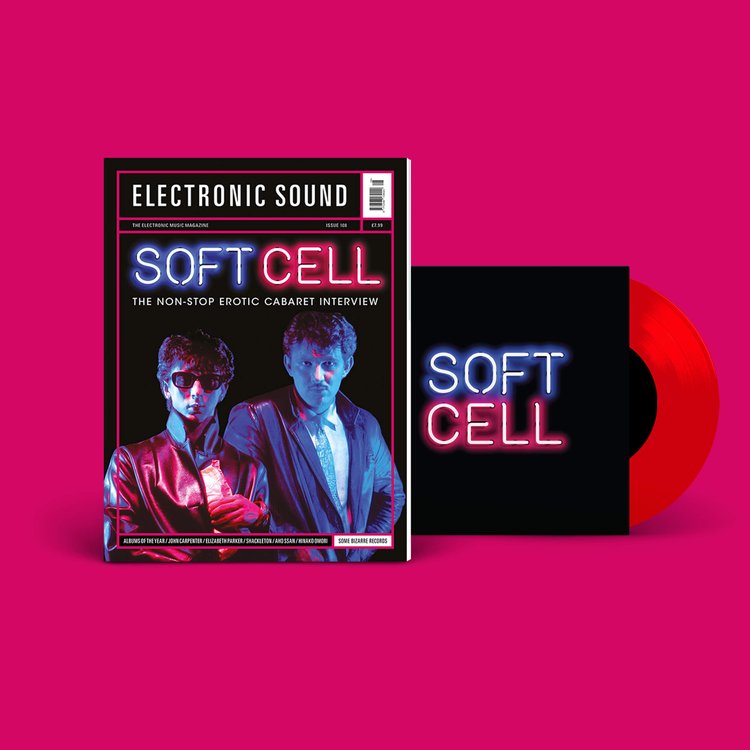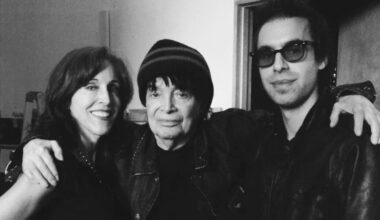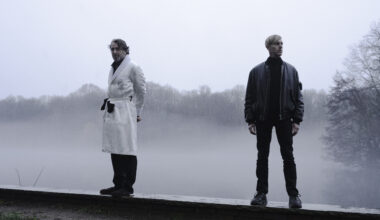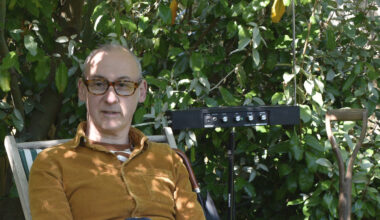As if being one half of Beaver & Krause wasn’t enough. Since his days as pioneering recording artist/Moog salesman extraordinaire Bernie Krause has carved out a further groundbreaking career as a respected sound archivist. We catch up on his recent exploits and then, in an extract from the recently republished ‘Becoming Elektra’ book, discover how the future-facing duo got their first break
From his current work as a bio-acoustician to his early days as a session musician who went on to enhance the work of artists like The Doors, The Byrds and Van Morrison, Bernie Krause is a key player in the development of electronic music and sound. As part of the duo Beaver & Krause, in 1967 they released ‘The Nonesuch Guide To Electronic Music’, which represents an instructive early index of the possibilities afforded by analogue synthesisers. While some sections sound like pure demonstration, others anticipate the polyrhythmic frenzy of the sort of 90s IDM produced by Autechre and their ilk.
Not that Krause is a noisenik himself. In his 2012 book, ‘The Great Animal Orchestra’, he refers to “the human din”, a pointed reference to the noise pollutions human beings generate which, among other things, deafens us to the ambient sounds of nature, whose beautiful, myriad sounds represent a plea for preservation.
Since the 1970s, and following the death of his long-time musical partner Paul Beaver in 1975, he has dedicated himself almost exclusively to the recording and archiving of natural sounds. He had first introduced these ideas on the 1970 quadrophonic Beaver & Krause album ‘In A Wild Sanctuary’, which ranges from grandiose synth sections to natural soundscapes designed to promote an ecological aliveness in the listener.
As a first port of call, visit his wildsanctuary.com website, which contains recordings of some 15,000 species.
Like compadres such as Chris Watson and even Luc Ferrari, his work probes and questions the borders between music and the natural world. By listening to the sounds he presents as if they were music, we take them less for granted and consequently take less for granted our rapidly disappearing environment.
Krause’s career, which spans almost 60 years, has taken many turns and travelled down numerous paths.
While still a young man, he found his musical feet as a session musician with the Tamla Motown label. He was brusquely informed when wishing to learn guitar at college that it was “not a musical instrument”, so Motown became his education.
“Motown was in its nascent stages,” explains Krause. “I was occasionally a student of their main session guitarist, Joe Messina, so when he couldn’t play, sometimes I sat in, driving in from the University of Michigan campus in Ann Arbor, to cover sessions for $5 a night. Because we were multi-tracking, it wasn’t clear which sessions I worked and I wasn’t very curious at the time. More than anything, I learned that I could cover the rhythm guitar styles well enough that I kept getting asked back. I was always a bit surprised, because I grew up in a family that did not instil a great deal of confidence in me or my efforts.”
Less probable and to his own surprise, he landed a job with folk group The Weavers as a replacement for Pete Seeger in 1963, the band’s last official year together. By this point, through his studies in Michigan, Krause was well aware of the work of Karlheinz Stockhausen and such forms as musique concrète. As such, it was unlikely he would stick to the folk route for very long and, moving to San Francisco to study electronic music at Mills College in Oakland, he encountered Stockhausen himself, who considered himself the finest composer in the world and was not averse to exuding the confidence that comes with such a self-assessment.
“In the mid-60s, he was lecturing nearby at UC Davis and would occasionally drop by Mills College for a talk,” says Krause. “While I met him there and attended some of his talks, I didn’t know him nor did we hang out.
Frankly, I never understood either the person or his work and found him, personally, to be a bit imperious and distant.”
Krause was, however, very much taken with earlier pioneers such as Edgard Varèse, as well as George Martin and the BBC Radiophonic Workshop – innovators who felt less remote than some of the haughtier giants of musique concrète.
It wasn’t until he met future collaborator Paul Beaver that they began to impact on the 60s mainstream music scene themselves, patching guitars, basses and vocals through the Moog filter on sessions that included The Doors’ ‘Strange Days’.
“He was an ultra-conservative libertarian, bisexual, and a Scientologist, and I was not,” recalls Krause of the improbable pairing with the late Beaver. “We were, nevertheless, good friends and perfect musical partners.
We had a lot of fun creating the five albums we managed to generate and enjoyed each other’s company.”

While they performed on a great many pop records, film soundtracks proved a much more amenable outlet for early electronic music. It was here that Krause really began to find a means to infiltrate public consciousness.
“Film music is designed to elicit emotional responses and to set the mood for different scenes,” he says. “Also, the synthesiser was used as an effect generator as with certain scenes in ‘Rosemary’s Baby’ or the helicopter sounds in ‘Apocalypse Now’, which we created.”
Evidently, he made a connection between creating electronic effects and his increasing interest in the environment…
“Our first album for Warner Brothers was ‘In A Wild Sanctuary’,” he explains. “Because the theme was ecology we decided we had to record natural sounds and incorporate them into the musical score. Paul was terrified of being outdoors so he left that job to me and off I went into nearby urban woods, the wildest place I’d ever been. When I turned on the recorder and heard the spatial impression of the park open up in my earphones, I decided then and there I wanted to do that for the rest of my life and made the determination to do just that.”
From Krause’s new field of sonic study arose a whole new lexicon, central to an understanding of his work.
“My particular field, soundscape ecology, embraces the study and interpretation of sound in the landscape and required new language to which I have contributed several terms,” he explains. “For example, over the course of several decades I came to realise that all acoustic signals emanate from three basic sources, the core palette and the anatomy of soundscapes from which we draw both information and inspiration. The first of these is the geophony – all of the non-biological sounds that occur in the natural world like the sound of a storm, the effect of wind in the trees or grasses, rain, sound of falling snow, water in a stream, waves crashing at the ocean shore, or even movement of the Earth.
“After thinking about it, I realised that geophonies were the first sounds that the Earth produced throughout the long arc of its formation. But, at the earliest stages, there were no organisms to hear them. Those came later, when the second of these sources, the biophony, evolved. Biophonies are the collective signatures created by all sound-generating organisms in a given habitat at a given moment. The third category is comprised of all the sound we humans produce, an output I refer to as the anthropophony.
“For purposes of simplicity, I divided this component into two sub-classes to distinguish between those sounds that contain important information, and those which we find irritating at some level or that contain nothing particularly germane to our well-being. Because the signals in this last sub-group tend to be disrupting and stressful – coming mostly from electro-mechanical technologies that one colleague refers to as technophony – they are categorised as noise.”
Driving Krause’s work is a concern for the ecologically parlous state of the planet. It’s poignant that some of his sound archive recordings are of habitats now extinct and yet, in the face of all evidence, the political resistance to addressing climate change is overwhelming, particularly in Krause’s home country.
“The USA is the only place I’ve ever been where such a large number of folks pride themselves on the level of their illiteracy – scientific, historic, cultural, political, geographic, social,” he says. “We tend to buy into narratives that support whatever fiction we’re fed, and respond most strongly when those messages engender fear. Then we’re fuelled with the idea that our exceptionalism will somehow overpower others, whoever they happen to be – usually those who speak a different language, come from a different place, look different, embrace a different deity. The xenophobia runs deep, whether it’s an idea or an actual person or culture. The future? I would describe myself as not optimistic, but hopeful.”
For more about Bernie Krause’s work, visit wildsanctuary.com
Get the print magazine bundled with limited edition, exclusive vinyl releases



In an exclusive extract from the newly revised and expanded edition of ‘Becoming Elektra: The True Story of Jac Holzman’s Visionary Record Label’, author Mick Houghton explains the role of the label’s Nonesuch offshoot and how it led to the doors of innovative electronic music swinging open for Beaver & Krause
Elektra Records and its spin-off label Nonesuch were among the first mainstream American labels to explore the possibilities of electronic music. Nonesuch was officially launched on February 14 1964 as a budget classical imprint, releasing its first 10 records with a simple ad campaign whose copy read, “Quality Recordings At The Price Of A Quality Paperback”.
In Nonesuch’s first year 60 titles were issued including Albinoni’s ‘Adagio for Strings & Organ’, Bach’s ‘Cantatas’, and ‘Masterpieces Of The Early French & Italian Renaissance’. It proved to be a highly profitable arm of the Elektra label which had been founded by 19-year-old Jac Holzman in 1950 while attending the liberal arts St John’s College in Annapolis, Maryland. For well over a decade, the output of the bijoux independent label hinged around a repertoire of mostly folk, embryonic world music and esoterica until, by the mid-60s, Holzman tilted Elektra towards nascent US rock with the release of albums by the Paul Butterfield Blues Band, Love, and The Doors.
It was the surprising success of Nonesuch that not only enabled Holzman to fund more costly rock recordings, but also allowed him to explore certain long-standing personal passions.
“Growing up I was a nerd,” says Holzman, “hanging out for hours in St John’s electronics lab, excited by oscillators and amplifiers, and at weekends I’d be rummaging in seedy stores in lower Manhattan for army and navy surplus gizmos that you could pick up in the post-war years and build quite sophisticated equipment.”
Holzman’s nerdish disposition led to such early Elektra releases as ‘Playback System Calibration Record’, ‘Elektra Code Course’ (a training disc using an oscillator fed directly to the disc cutting head) and ‘Flight Kit’, simulated ground to air communications for light aircraft enthusiasts. By 1967, Holzman’s fascination with technological advances combined with an awareness of avant-garde music ultimately led to him commissioning such key albums as The Zodiac’s ‘Cosmic Sounds’, which is often cited as the first significant use of a Moog on a pop or rock record, ‘Silver Apples Of The Moon’ by Morton Subotnick, one of the pioneers of the Buchla touch-pad synthesiser and, of course, Beaver & Krause’s ‘Nonesuch Guide To Electronic Music’.
In fact, it was Holzman who was responsible for bringing Paul Beaver and Bernie Krause together. Somewhat improbably, Bernie Krause had been a banjo player in The Weavers, the final replacement for Pete Seeger.
“After I graduated from the University of Michigan in 1960, I went to grad school in Boston, at MIT. As a musician I was more interested in jazz, but capable in folk music playing guitar and banjo; I got a job working for [leading local promoter-manager] Manny Greenhill booking major folk acts. That’s when I first met Jac; everybody knew Jac and Jac knew everybody because he was hanging out at the clubs looking for talent. We booked The Weavers in October 1962. I thought they were old hat so I was doing a satirical take on Weavers’ songs at Club 47, where Lee Hays [guitarist and founder member with Seeger] caught the end of my set. He said, ‘If you’re such a wiseass, why don’t you audition for the Pete Seeger chair?’. They needed somebody to play banjo and sing tenor for a reunion tour that was coming up. So I went along; I was one of 300 who did the audition, and I got the job, but I never contributed much to The Weavers who by then were old hat and very soon broke up.”
Krause can be heard on ‘The Weavers – Reunion At Carnegie Hall 1963’, released by the Vanguard label.
After the Weavers, Krause went home to Detroit and worked as a contract musician at Motown before heading to California in 1965.
“I attended a series of lectures by Stockhausen,” recalls Krause, “and I began working with some of the newly developed modular instruments at the Tape Music Center at Mills College in San Francisco. My mind was made up that I wanted to study electronic music; there were only two analogue synthesisers on the market: Mills College had the Buchla, but I’d seen Robert Moog’s first prototype in operation in New York and I couldn’t take my eyes of it.
“It was around this time that I met Paul Beaver through Jac Holzman, who called me because he’d heard I was working with synthesisers. He’d just hired Paul for this piece of astrological nonsense that became ‘Cosmic Sounds’. Paul and I just hit it off. We were able to come up with enough money to buy one of Robert Moog’s early models for $15,000, which was delivered to Paul’s warehouse in the spring of 1967; it was a one-storey red brick warehouse, pretty funky, and falling apart more with each earthquake. Inside he had the largest collection of Novachords, the first synthesiser, built by Hammond in the 30s.”
Beaver and Krause had agreed to become Moog’s sales reps on the West Coast and had secured a small space at the Monterey Pop Festival, where they were going to demonstrate the practicalities and potential of the Moog in their booth, successfully turning on The Byrds, George Harrison, and Micky Dolenz of The Monkees to the synthesiser’s possibilities. The results of their explorations can be heard on ‘The Notorious Byrds Brothers’, The Monkees’ ‘Pisces, Aquarius, Capricorn & Jones Ltd’ and George Harrison’s ‘Electronic Sound’, a highly contentious “collaboration” with Krause who was flown to London to show Harrison how to play the instrument.
“Paul was more the technical wizard,” says Krause, “and he was also very good on keyboard. He’d been a successful jazz organist. I’m terrible at the keyboard, but I had very good musical ideas, so together it worked. Paul was already an experienced keyboardist and special effects man on countless B-movie soundtracks and television shows. He was able to realise my ideas on the Moog in ways that I could not have done. We spent months tirelessly exploring how to fully operate the Moog, because there was no detailed manual. We were teaching people the basics, and at the same time Paul was explaining the technical aspects to me. I was recording all the sessions to learn from and making extensive notes.”
Beaver and Krause were fast becoming a highly visible team as session musicians, yet the pair couldn’t get anyone in Hollywood or any record companies interested in recording electronic music until they were finally given the opportunity by Tracey Sterne at Nonesuch, who was brought in by Holzman to run the rapidly expanding and diversifying label.
“When we were on the plane to Monterey,” says Krause. “I happ-ened to sit next to Jac Holzman. I was telling him what Paul and I were doing and he said, ‘Why don’t you guys put together an album?’ and that was how the ‘The Nonesuch Guide To Electronic Music’ came about. I transcribed all my notes from the learning sessions, which became the basis for the 16-page booklet, and we compiled the music; it’s still the standard reference in the industry.
“It was on the Billboard charts for 26 weeks; that was our debut album, and it certainly got our names out there. We were surprised how well it did, even Jac didn’t see it as being a big seller, but he was the last of the great risk-takers of that era. He always trusted his instincts. Our guide to electronic music fulfilled a need and Jac’s extraordinary level of credibility at the time, and Elektra’s standing was a factor its success. Jac had such insight into areas where nobody else really saw the possibilities.”
Originally issued as a double album in 1968, ‘The Nonesuch Guide To Electronic Music’ contained 68 short tracks over four LP sides. It was revolutionary because the pieces demonstrated each module of the synthesiser, without accompaniment, rather than deploying it as an atmospheric instrument to enhance other instruments, as was the norm at the time.
“It was the key to introducing the synthesiser into pop music and film,” says Krause, “something that broke down all the walls in the music business. Jac’s vision gave a voice in the world to a new musical instrument, in effect the first to be successfully introduced since the saxophone a century before.”
As Beaver & Krause, the duo was eventually able to record their own unique brand of rock music; their two best-remembered LPs were made for Warner Brothers: ‘In A Wild Sanctuary’ in 1970 and, a year later, ‘Gandharva’, recorded live in San Francisco’s Grace Cathedral. They were by now doing film work together and plenty more followed either collectively and/or individually over the rest of the decade and beyond which found Beaver and Krause contributing to soundtracks for ‘Point Blank’, ‘Cool Hand Luke’, ‘Rosemary’s Baby’, ‘Candy’, ‘Catch 22’, ‘They Shoot Horses, Don’t They?’ and ‘Performance’, which was released in 1970 by Warner Brothers in between the first two Beaver & Krause albums and represents arguably the apotheosis of Krause’s synthesiser-based pieces.
“Between us,” remembers Krause, “we worked on 135 features and probably some 250 albums. If pushed, the ‘Performance’ soundtrack is my favourite; it really complements what’s on screen. Paul and I were both working about 80 hours a week for sessions and making good money, but not for our own work. We were the go-to guys in that field, and we were still representing Moog, selling synthesisers, and teaching people how to use them, but by 1972 the bloom was off the rose, and our career as studio musicians was declining rapidly. We sowed the seeds of our own decline because people were now using the Moog themselves; the Minimoog was more adaptable, and we had a lot of competition with ARP.
“I’m proud of all the albums we made together. ‘In A Wild Sanctuary’ was the first album on the theme of ecology and the first album that used natural soundscapes as a component of orchestration. It made such an impression that it changed my life: it gave me something to really aim for when Paul died.”
Paul Beaver died suddenly on 16 January 1975, at the age of 49, with Krause eventually pursuing the new direction inspired by his field work for ‘In A Wild Sanctuary’, earning a PhD in Creative (Sound) Arts, specialising in bioacoustics from Union Institute & University in Cincinnati in 1981. It was an area he was already in the process of defining, travelling around the world and adventurously recording eco-systems. He has recorded and produced a series of environmental recordings for the Nature Company and his own Wild Sanctuary label.
‘Becoming Elektra: The True Story Of Jac Holzman’s Visionary Record Label’ by Mick Houghton is published by Jawbone






